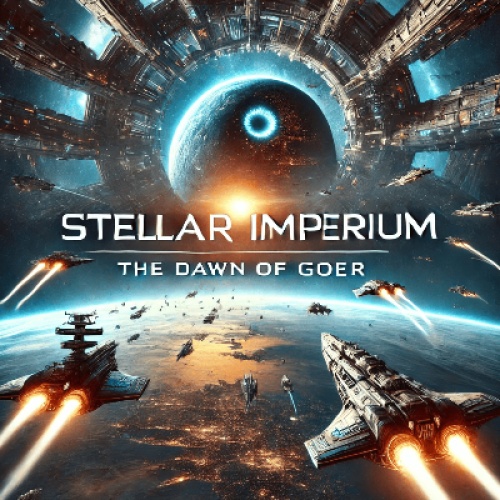Earth in 2096
The year is 2096. Earth is no longer the center of human civilization - it is a relic, a scarred world recovering from the excesses of its past. The climate wars of the mid-21st century left nations broken, borders redrawn, and billions displaced. Yet, from the ashes of that devastation, humanity found purpose beyond its dying cradle.
The discovery of faster-than-light travel in 2068, made possible by the Alcubierre-Vasquez Drive, changed everything. No longer bound to a single planet, corporations and governments alike set their sights on the stars. The Moon and Mars became staging grounds, their surfaces dotted with self-sustaining colonies. Asteroid mining boomed, fueling a new era of industrial expansion. The first extrasolar outposts were established in the Proxima Centauri system in 2079. With resources abundant beyond Earth's atmosphere, the nations of old formed fragile alliances to ensure humanity's foothold among the stars.
Out of necessity, the Galactic Order of Exploration & Regulation (GOER) was born.
GOER was neither a government nor a corporation, but something in between - a coalition of Earth's surviving superpowers and interstellar conglomerates. Its mandate was simple in theory, yet infinitely complex in execution: to explore, regulate, and safeguard humanity's expansion into the cosmos. But in practice, GOER was a battleground of ideologies, where idealists clashed with pragmatists, and corporate interests vied for control.
The Mandate of GOER
Founded in 2082, GOER was tasked with three primary objectives:
1. Exploration & Colonization - To map and settle habitable exoplanets, ensuring sustainable expansion.
2. Regulation & Oversight - To prevent unrestrained corporate exploitation and maintain interstellar law.
3. Defense & Diplomacy - To protect human colonies from extraterrestrial threats and establish peaceful relations with alien civilizations.
At its helm sat High Commander Cassian Voss, a seasoned statesman and former admiral, chosen for his ability to navigate both the political and military spheres. But even he understood that GOER's authority was tenuous at best. While Earth's governments saw it as a necessity, megacorporations viewed it as a bureaucratic leash. To some, it was a symbol of unity; to others, a machine built to consolidate power.
GOER's Internal Politics
Beneath its outward mission, GOER was riddled with internal divisions. The organization was governed by a High Council, consisting of representatives from Earth's remaining superpowers, influential megacorporations, and scientific think tanks. Yet, decision-making was rarely straightforward. Earth's governments, still recovering from past conflicts, prioritized stability, while corporate factions, such as Nexus Dynamics and Helios Industries, lobbied for unrestricted access to new resources. Meanwhile, a growing faction within GOER, led by Councilor Nyx Calderon, pushed for a more militarized approach, fearing the emergence of unknown extraterrestrial threats.
Espionage and subterfuge were commonplace. Rival factions planted spies within GOER's ranks, and confidential reports were routinely leaked to corporate executives and government officials. Calderon's intelligence division, The Black Veil, operated in the shadows, uncovering corruption but often engaging in their own clandestine dealings. Even Cassian Voss, for all his ideals, was forced to make uneasy alliances to maintain order.
The Colonies: Foundations of a New Era
Beyond Earth, the colonies were as diverse as the people who built them.
? Luna Prime (The Moon) - Humanity's first major off-world settlement, now a political hub for interstellar diplomacy and a neutral ground for GOER's High Council meetings.
? Redhaven (Mars) - A thriving, corporate-dominated colony built in the wake of Mars' terraforming efforts, known for its cutting-edge scientific research and corporate intrigue.
? Erebus Station (Europa) - A deep-space research station devoted to studying alien microbiology beneath Europa's ice sheets, rumored to house classified GOER experiments.
? Horizon Outpost (Proxima Centauri b) - The first extrasolar colony, a fragile foothold in deep space, constantly under threat from resource shortages and the unknown dangers of the frontier.
Each colony faced unique struggles - political disputes, supply shortages, or outright rebellion. While GOER sought to regulate them, many colonies harbored resentment, seeing GOER as an extension of Earth's overreach rather than a protector of humanity's interests.
Hidden Agendas: Shadows in the Void
As GOER expanded its reach, so too did those who sought to exploit the vastness of space. Beneath the surface, black-market syndicates like the Orion Cartel thrived, smuggling illicit tech and stolen resources across the void. Rogue operators, including former GOER officers turned mercenaries, carried out unsanctioned missions in uncharted sectors. Rumors of The Silent Accord, a shadowy organization working to manipulate GOER from within, grew stronger with each passing year.
And then, there were whispers of something far older than humanity lurking in the dark corners of the galaxy - an ancient presence watching, waiting. Some within GOER dismissed such tales as paranoia, but others, like Nyx Calderon, weren't so sure.
As GOER's fleets expanded into uncharted space, they carried with them the hopes and fears of a species standing at the precipice of its greatest era. But for all the optimism surrounding this new age, the shadows of humanity's past remained ever-present. Earth had not changed - only its ambitions had.
And in the darkness beyond the stars, something was watching.







